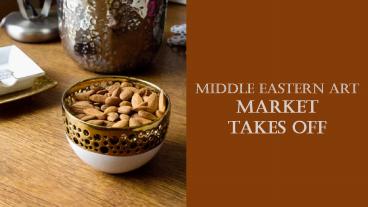Middle Eastern Art Market Takes Off - PowerPoint PPT Presentation
1 / 7
Title:
Middle Eastern Art Market Takes Off
Description:
Fine art objects are tangible assets and can be traded as currency, at auction or, increasingly, online. – PowerPoint PPT presentation
Number of Views:34
Title: Middle Eastern Art Market Takes Off
1
Middle Eastern art market takes off
2
MIDDLE Eastern art investment has become a
popular channel for prudent private and corporate
investors to hedge against fluctuations in
conventional financial markets, particularly amid
the ongoing economic turmoil.
Fine art objects are tangible assets and can be
traded as currency, at auction or, increasingly,
online. The financial benefits of investing in
art are security of owning a physical asset and
the potential for growth in value, coupled with
the status and enjoyment of owning a fantastic
piece of art.
3
Buying fine art is a way of diversifying an
investment portfolio, allowing you to either
build a collection of disparate individual pieces
or focus on a group of artists with similar
mediums and themes. But what should you know
before taking the plunge into the world of art
investment? cashy takes a look...
4
Experts' advice Experts advise investors to
firstly understand that art investment requires a
long-term view of at least seven to ten years.
Of course, you could sell sooner if market
conditions are favourable. Michael Jeha,
managing director Christies Dubai, says Its
important to remember that Middle Eastern art
interest has grown and developed from a solid
base and, therefore, offers a stable investment
over time. Secondly, research the popularity,
interest and resale value at auction of classic
and trendy artists. Thirdly, take advice from
specialists at art galleries and auction houses
on reputable sourcing, purchase price and resale
potential. Most auction houses will give free
valuations, but take into account the high costs
involved in selling on a work of art, including
auctioneer handling fees and commission. Lastly,
choose artists, time-periods or styles that most
appeal to you as an individual investor you want
to enjoy the artwork for its own sake for as long
as possible.
5
Market grows When Christies held its inaugural
auction of Middle Eastern art in Dubai in May
2006, it boosted collectors interest by creating
a new international platform for art purchase
from the region. Jeha says that sales are
currently split between international and Middle
Eastern collectors. Private and public galleries
and international auction houses in the region
are making great strides in representing
contemporary artists. Some have shown large
installation pieces and sculptures, the quality
of which is on a par with works exhibited on the
worlds biggest international art markets. Over
the past five years, Christies Dubai has held
twice-yearly auctions of modern and contemporary
Arab, Iranian and Turkish art, jewels and
watches, achieving sales of over 200 million.
Global buying activity among Middle Eastern
clients has increase by over 400 during that
period.
6
Whats hot? In April this year, Christies Dubai
put works by Paul Guiragossian, Fateh Moudarres,
Farhad Moshiri and Mohammed Ehsai under the
hammer. It also sold works by the Saudi Arabian
group Edge of Arabia, with Abdulnasser Gharems
Messenger, estimated to sell for 70,000 to
100,000, going for a mammoth 842,500. Mona
Hauser, owner XVA gallery in Dubai, says that
those starting out as art investors should look
to great corporate art collections and art funds
that are paving the way for nurturing the Middle
East arts environment, such as those owned by
Credit Suisse, Abraaj and Sovereign. There are
also strong private collections that go on show
in public spaces, at times, such as the Farjam
Collection, one of the finest privately-owned
Islamic art collections in the world. Thousands
of objects from the collection appeared for the
first time in Dubai this summer, with the
exhibition spanning almost the entire history of
Islam and including some of the rarest artistic
masterpieces of the Islamic world.
7
Other private collections to follow include the
Barjeel, Farook and Salsali Collections. Hauser
says These collectors are sophisticated and
savvy about their collecting decisions it is
worth looking into what they buy to learn about
trends in the market for contemporary Middle
Eastern art. All collect a diversity of
artists work. Investors should look towards
adding Middle Eastern art to their portfolio as
the markets reputation is continuously getting
stronger, gaining attention and
credibility. Photography has also attracted a
lot of attention recently in the Middle Eastern
market and it is becoming increasingly popular.
Hauser adds XVA represents a number of talented
photographers one very popular practitioner is
Halim Al Karim, who along with other artists is
pushing the boundaries of contemporary Middle
Eastern art.
Article source http//www.cashy.me/articles/post/
2011/08/09/middle-eastern-art-market-takes-off/424
/?cct67ccid424 Image source
https//www.letternoon.com/































